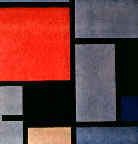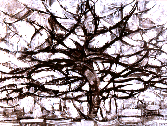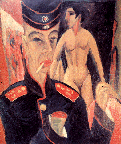

 The
Cubists were also intrigued by the work of Cezanne, but their interest was in
form more than color. They were interested in the relativity of changing viewpoint,
as affected by either change of position in space or time. The attempt was to
show all points of view simultaneously. The broken, faceted surfaces
were expressions of this relativity, as well as being an exploration of the underlying
shape relationships, often reduced to their basic geometric components. The handling
of form, particularly of human form, was also inspired by African sculpture. Major
cubist artists included
Picasso
and Georges Braque.
The
Cubists were also intrigued by the work of Cezanne, but their interest was in
form more than color. They were interested in the relativity of changing viewpoint,
as affected by either change of position in space or time. The attempt was to
show all points of view simultaneously. The broken, faceted surfaces
were expressions of this relativity, as well as being an exploration of the underlying
shape relationships, often reduced to their basic geometric components. The handling
of form, particularly of human form, was also inspired by African sculpture. Major
cubist artists included
Picasso
and Georges Braque.

 Piet Mondrian
was the major painter in the de Stijl movement, a specifically Dutch movement
which would have great influence on subsequent Art and Design developments.
This highly intellectual and even mystical style depended upon a very rigorous
limitation of form to simple rectilinear divisions of space into variously sized
color fields. The subject matter was color and proportion, presented so as to
have its most pure impact upon the viewer's sensibilities.
Piet Mondrian
was the major painter in the de Stijl movement, a specifically Dutch movement
which would have great influence on subsequent Art and Design developments.
This highly intellectual and even mystical style depended upon a very rigorous
limitation of form to simple rectilinear divisions of space into variously sized
color fields. The subject matter was color and proportion, presented so as to
have its most pure impact upon the viewer's sensibilities.
This style would in turn influence such Bauhaus artists as Joseph Albers, Paul Klee, and through them, contribute to the Op Art and Minimalist styles of the 1960's and 70's.
If you would like to try a game in which you play with the color proportion ideas of Mondrian, try this site.
 The shock and horror of World War I (1914-1918), which decimated Europe and killed
the flower of an entire generation, resulted in immense disillusionment with traditional
values and modes of discovering truth. DaDa
developed during and shortly after the war in Zurich, Switzerland. It was
anarchistic in intention, and essentially "anti-art." DaDa artists sought to create
art which was essentially concept, with the form and materials being inconsequential.
DaDa art was intended to be impermanent; the creation and idea of the artwork
was its only purpose. The object was not to be venerated, but rather to be destroyed
once the creation was completed. Frequently ordinary manufactured objects were
assembled into DaDa art, and collaboration between artists, poets, and musicians
were typical DaDa "events." Among the important contributors to DaDa were Jean
Arp, Man Ray,
Marcel
Duchamp, Kurt Schwitters.
The shock and horror of World War I (1914-1918), which decimated Europe and killed
the flower of an entire generation, resulted in immense disillusionment with traditional
values and modes of discovering truth. DaDa
developed during and shortly after the war in Zurich, Switzerland. It was
anarchistic in intention, and essentially "anti-art." DaDa artists sought to create
art which was essentially concept, with the form and materials being inconsequential.
DaDa art was intended to be impermanent; the creation and idea of the artwork
was its only purpose. The object was not to be venerated, but rather to be destroyed
once the creation was completed. Frequently ordinary manufactured objects were
assembled into DaDa art, and collaboration between artists, poets, and musicians
were typical DaDa "events." Among the important contributors to DaDa were Jean
Arp, Man Ray,
Marcel
Duchamp, Kurt Schwitters.

 These emotionally charged images rely on distortions of color and form to achieve
their impact. Among the artists of this movement are Kirchner, Beckmann, and Grosz.
The Norwegian Munch
was also working in a related style before world war I, producing powerfully emotional
images.
These emotionally charged images rely on distortions of color and form to achieve
their impact. Among the artists of this movement are Kirchner, Beckmann, and Grosz.
The Norwegian Munch
was also working in a related style before world war I, producing powerfully emotional
images.
The exhibition of Art held in Munich in 1937 was mounted by the Nazis to mock the modern styles. By the end of the 1930's many of the great artists and intellectuals of Europe were moving to the United states to escape the rise of Nazism. Thus it came to be believed that Europe was under a shadow - that the intellectual center of the West was now shifting to New York.
| |
 |